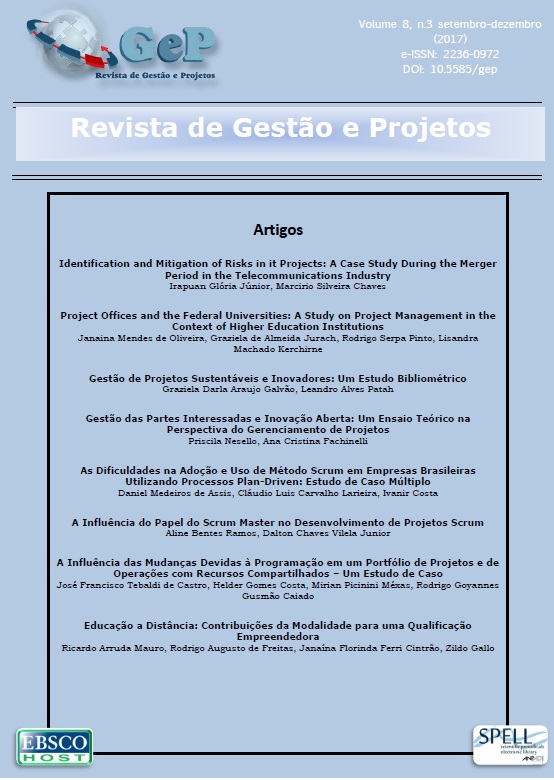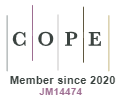Gestão das Partes Interessadas e Inovação Aberta: Um Ensaio Teórico na Perspectiva do Gerenciamento de Projetos
DOI:
https://doi.org/10.5585/gep.v8i3.521Palabras clave:
Gerenciamento de Projetos, Abordagens Ágeis, Abordagens Tradicionais, Inovação Aberta, Gestão das Partes Interessadas.Resumen
A inovação aberta tem como um de seus principais fundamentos o compartilhamento de informações e conhecimento com atores externos. A complexidade de projetos de inovação aberta é elevada em grande parte devido ao número de partes interessadas que os compõe. Portanto, planejar e gerenciar partes interessadas é fator determinante de sucesso para projetos desta natureza. O presente artigo aborda tais questões em um ensaio teórico, que teve como objetivo discutir a integração de diferentes abordagens de gerenciamento de projetos para uma melhor gestão das partes interessadas em projetos de inovação aberta. A visão desenvolvida ao longo da última década propõe um alinhamento entre abordagens ágeis de gerenciamento de projetos e inovação aberta. Contudo, o modelo conceitual desenvolvido mostra que as abordagens tradicionais podem também contribuir ao fornecerem um corpo de conhecimento estruturado, que proporciona apoio aos gerentes de projetos.
Citas
APM, Association for Project Management. (2006). APM Body of Knowledge (5nd ed.). Princes Risborough, UK: Autor.
Appelo, J. (2011). Management 3.0: leading Agile developers, developing Agile leaders. Boston, MA: Addison-Wesley.
Appleyard, M. M., & Chesbrough, H. W. (2017). The dynamics of open strategy: from adoption to reversion. Long Range Planning, 50(3), 310-321.
AXELOS (2017). Managing Successful Projects with PRINCE2. Londres, UK: The Stationery Office Books.
Beck, K., & Anders, C. (1999). Extreme programming eXplained: embrace change. Boston, MA: Addison-Wesley.
Boscherini, L., Chiaroni, D., Chiesa, V., & Frattini, F. (2010). How to use pilot projects to implement Open Innovation. International Journal of Innovation Management, 14(06), 1065-1097.
Chesbrough, H. (2003). The era of open innovation. MIT Sloan Management Review, 44(3), 45-41.
____________. (2004). Managing open innovation. Research-Technology Management, 47(1), 23-26.
Chiaromonte, F. (2006). Open innovation through alliances and partnership: theory and practice. International journal of technology management, 33(2-3):111-114.
Christensen, C. M. (1997). The Innovator's Dilemma: The Revolutionary Book that Will Change the Way You Do Business (Collins Business Essentials).
Chesbrough, H., & Bogers, M. (2014). Explicating Open Innovation: Clarifying an Emerging Paradigm for Understanding Innovation. In Chesbrough, H., Vanhaverbeke, W. and West, J., eds., New frontiers in open innovation, Oxford: Oxford University Press, 3-28.
Christensen, C. M., Anthony, S. D., & Roth, E. A. (2007). O futuro da inovação. Rio de Janeiro: Elsevier.
Clark, K. B, & Wheelwright, S. C. (1993). Managing new product and process development. New York: The Free Press.
Cleland, D. I., & Kerzner, H. (1985). A project management dictionary of terms. New York: Van Nostrand Reinhold.
Conboy, K. (2009). Agility From First Principles: Reconstructing The Concept of Agility in Information Systems Development. Information Systems Research, 20(3), 329-354.
Conboy, K., & Morgan, L. (2010). Future research in agile systems development: applying open innovation principles within the agile organisation. In Agile Software Development (pp. 223-235). Springer Berlin Heidelberg.
______________________. (2011). Beyond the customer: Opening the agile systems development process. Information and Software Technology, 53(5), 535-542.
Conforto, E.; Barreto, F.; Amaral, D. C.; Rebentisch, E. (2015). Modelos Híbridos: unindo complexidade, agilidade e inovação. Revista Mundo PM, 11(64), 10-17.
da Rosa, J. P. C., & Esteves, P. C. L. (2017). Gestão das Partes Interessadas no Contexto das Metodologias de Gestão de Projetos. Revista Espacios, 38(21).
Dahlander, L., & Gann, D. M. (2010). How open is innovation? Research policy, 39(6), 699-709.
Dias, A. M. M., Jeunon, E. E., & da Cunha Duarte, L. (2016). Gestão das Expectativas das Partes Interessadas: Um Estudo da Percepção dos Profissionais em Gestão de Projetos. Revista Inovação, Projetos e Tecnologias, 4(2), 208-222.
de Bem Noro, G. (2012). A gestão de stakeholders em gestão de projetos. Revista de Gestão e Projetos-GeP, 3(1), 127-158.
de Moura, R. L., & Diniz, B. D. (2016). Analisando Projetos através das Práticas: Um Ensaio Teórico. Revista de Gestão e Projetos-GeP, 7(2), 34-41.
de Vasconcellos Dullius, P. A., & Macadar, M. A. (2014). Gestão de Projetos e Estudos Organizacionais: Dois Lados da Mesma Moeda. Revista de Gestão e Projetos-GeP, 5(1), 100.
Dodgson, M., Gann, D., & Salter, A. (2006). The role of technology in the shift towards open innovation: the case of Procter & Gamble. R&D Management, 36(3), 333-346.
Enkel, E. (2007). The optimal way to cooperate: Scientific analysis underlines the successful concept. ABB Review, 3, 6-8.
Enkel, E., Perez‐Freije, J., & Gassmann, O. (2005). Minimizing market risks through customer integration in new product development: learning from bad practice. Creativity and Innovation Management, 14(4), 425-437.
Felin, T., Lakhani, K. R., & Tushman, M. L. (2017). Firms, crowds, and innovation. Strategic Organization, 15(2), 119-140.
Franzoni, C., & Sauermann, H. (2014). Crowd science: The organization of scientific research in open collaborative projects. Research Policy, 43(1), 1-20.
Gassmann, O., & Enkel, E. (2004 July). Towards a theory of open innovation: three core process archetypes. In R&D management conference, 6, 1-18).
Freeman, R. E. (2013). Strategic Management: A Stakeholder Approach [Kindle Edition]. Cambridge: Cambridge University Press.
Gomes, M. B., de Oliveira Pazeto, A. B., Tractenberg, L. E. F., & Junior, L. P. P. (2017). Gestão de stakeholders (GS) no gerenciamento de projetos (GP): casos múltiplos sob a luz do PMBOK. South American Development Society Journal, 3(07), 158-173.
Guertler, M. R., von Saucken, C., Schneider, M., & Lindemann, U. (2015). How to search for Open Innovation partners. In International Conference on Engineering Design.
Hage, J., & Hollingsworth, R. (2000). A strategy for the analysis of idea innovation networks and institutions. Organization Studies, 21, 971-1004.
Harhoff, D., & Lakhani, K. R. (Eds.). (2016). Revolutionizing innovation: Users, communities, and open innovation. Cambridge, MA: MIT Press.
Henkel, J., Schöberl, S., & Alexy, O. (2014). The emergence of openness: How firms learn selective revealing in open innovation. Research Policy, 43(5).
IPMA, International Project Management Association. (2015). IPMA Individual Competence Baseline Version 4.0. Amsterdam: Autor.
Kohler, T., Matzler, K., & Füller, J. (2009). Avatar-based innovation: Using virtual worlds for real-world innovation. Technovation, 29 (6-7), 395-407.
Laursen, K., & Salter, A. J. (2014). The paradox of openness: Appropriability, external search and collaboration. Research Policy, 43(5), 867-878.
Lee, N., Sameen, H., & Cowling, M. (2015). Access to finance for innovative SMEs since the financial crisis. Research policy, 44(2), 370-380.
Lindner, F., & Wald, A. (2011). Success factors of knowledge management in temporary organizations. International Journal of project management, 29(7), 877-888.
Lundin, R. A., & Söderholm, A. (1995). A theory of the temporary organization. Scandinavian Journal of management, 11(4), 437-455.
Meneghetti, F. K. (2011). O que é um ensaio-teórico? RAC-Revista de Administração Contemporânea, 15(2).
Mina, A., Bascavusoglu-Moreau, E., & Hughes, A. (2014). Open service innovation and the firm's search for external knowledge. Research Policy, 43(5), 853-866.
OCDE, Organização para cooperação e desenvolvimento econômico. (2005). Diretrizes para coleta e interpretação de dados sobre inovação. (3nd ed.). Rio de Janeiro, RJ: ARTI/FINEP.
Oppong, G. D., Chan, A. P., & Dansoh, A. (2017). A review of stakeholder management performance attributes in construction projects. International Journal of Project Management, 35(6), 1037-1051.
Ovanessoff, A., Plastino, E., & Faleiro, F. (2015). Por que o Brasil precisa aprender a confiar na inovação colaborativa. São Paulo, SP. Accenture.
Packendorff, J. (1995). Inquiring into the temporary organization: new directions for project management research. Scandinavian journal of management, 11(4), 319-333.
Piller, F. T.; Walcher, D. (2006). Toolkits for idea competitions: A novel method to integrate users in new product development. R and D Management, 36(3), 307-318.
Pisano, G. P., & Verganti, R. (2008). Which kind of collaboration is right for you. Harvard business review, 86(12), 78-86.
PMI, Project Management Institute. (2013). A Guide to the Project Management Body of Knowledge (5nd ed.). Filadélfia, PA: Autor.
Pałucha, K. (2012). Innovation process management. Archives of Materials Science and Engineering, 58(1), 33-39.
Parida, V., Oghazi, P., & Ericson, Å. (2014). Realization of Open Innovation: A Case Study in the Manufacturing Industry. Journal of Promotion Management, 20 (3), 372-389.
Pisano, G. P., & Verganti, R. (2008). Which kind of collaboration is right for you? Harvard Business Review, 86 (12), 78–86.
Praest, K. M.; Bøtker M. T. (2011). Some immediate but negative effects of openness on product development performance. Technovation, 31 (1), 54-64.
Powell, W., Koput, K. W., & Smith-Doerr, L. (1996). Interorganizational collaboration and the locus of innovation: networks of learning in biotechnology. Administrative Science Quarterly, 41, 116-145.
Richardson, G. B. (1972). The organization of industry. Economic Journal, 82(327), 883-896.
Rogers, M. E. (2003). Diffusion of innovations (5nd ed.). New York: The Free press.
Rothwell, R. (1994). Towards the fifth-generation innovation process. International marketing review, 11(1), 7-31.
Rowlinson, S., & Cheung, Y. K. F. (2008). Stakeholder management through empowerment: modelling project success. Construction Management and Economics, 26(6), 611-623.
Schwab, K. (2016). The Global Competitiveness Report 2016–2017. Genebra: W.E. Forum.
_________. (2016a). A Quarta Revolução Industrial. São Paulo, SP: Edipro.
Salge, T.O., Farchi, T., Barrett, M. I., & Dopson, S. (2013). When does search openness really matter? A contingency study of health-care innovation projects. Journal of Product Innovation Management, 30 (4), 659-676.
Steinberg, S., & DeMaria, R. (2012). The Crowdfunding Bible: How to raise money for any startup, video game or project. Northumberland, UK: Read. me.
Schumpeter, J. A. (1934). The theory of economic development: An inquiry into profits, capital, credit, interest, and the business cycle. Piscataway, NJ: Transaction publishers.
Schwaber, K. (2004). Agile project management with Scrum. Redmond, WA: Microsoft Press.
Schwaber, K., & Beedle, M. (2002). Agile software development with SCRUM. Upper Saddle River, NJ: Prentice Hall.
Schwaber, K., & Sutherland, J. (2011). The scrum guide. Westminster, CO: Scrum Alliance.
Shin, K. S. (2013). Adaptive Framework for Designing R&D Project Management Process Using Cloud Computing Technology. Journal of Society for e-Business Studies, 18(4).
Srivannaboon, S., & Munkongsujarit, S. (2016, September). Project management and project portfolio management in open innovation: Literature review. In Management of Engineering and Technology (PICMET), 2016 Portland International Conference on, 2002-2007.
Stanko, M. A., & Henard, D. H. (2017). Toward a better understanding of crowdfunding, openness and the consequences for innovation. Research Policy, 46(4), 784-798.
Sutherland, J. (2014). Scrum - a arte de fazer o dobro de trabalho na metade do tempo. Rio de Janeiro, RJ: LEYA Editora Ltda.
Takeuchi, H., & Nonaka, I. (1986). The new new product development game. Harvard business review, 64(1), 137-146.
Terwiesch, C., & Xu, Y. (2008). Innovation contests, open innovation, and multiagent problem solving. Management science, 54(9), 1529-1543.
The Standish Group (2015). The CHAOS Manifesto. Boston, MA: Autor.
Tidd, J., Bessant, J., & Pavitt, K. (2005). Managing innovation: integrating technological, managerial organizational change. New Jersey: Wiley.
Tranekjer, T. L., & Søndergaard, H. A. (2013). Sources of innovation, their combinations and strengths–benefits at the NPD project level. International Journal of Technology Management 12, 61(3/4), 205-236.
Turner, R., Anbari, F., & Bredillet, C. (2013). Perspectives on research in project management: the nine schools. Global Business Perspectives, 1(1), 3-28.
VersionOne, Inc. (2015). 9TH Annual State of AgileTM Survey. Disponível em: http://info.versionone.com/state-of-agile-development-survey-ninth.html. Acesso em 02/05/2015.
von Hippel, E. A. (2005). Democratizing innovation. Cambridge, MA: The MIT Press.
von Saucken, C., Guertler, M., Schneider, M., & Lindemann, U. (2015). A method model for distinguishing and selecting open innovation methods. In DS 80-8 Proceedings of the 20th International Conference on Engineering Design (ICED 15) Vol 8: Innovation and Creativity, Milan, Italy, 27-30.07. 15.
West, J. (2014). Challenges of Funding Open Innovation Platforms: Lessons from Symbian Ltd. In Chesbrough H., Vanhaverbeke W. & West J., New Frontiers in Open Innovation, Oxford: Oxford University Press, 29-49.
West, J., Salter, A., Vanhaverbeke, W., & Chesbrough, H. (2014). Open innovation: The next decade. Research Policy, 43(5), 805-811.
Descargas
Publicado
Cómo citar
Número
Sección
Licencia
Derechos de autor 2017 Priscila Nesello, Ana Cristina Fachinelli

Esta obra está bajo una licencia internacional Creative Commons Atribución-NoComercial-SinDerivadas 4.0.
- Resumen 953
- PDF (Português (Brasil)) 1572







